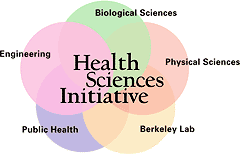|
HOME SEARCH ARCHIVE |
|
Effort addresses health effects of pesticides and allergens on rural mothers and babies
By Diane Ainsworth, Public Affairs
| |
 |
The CHAMACOS project, which stands for the Center for the Health Assessment of Mothers and Children of Salinas, is the first long-term research study to investigate the potential adverse health effects of children's daily exposure to pesticides and allergens such as pollens, molds and dusts.
"This is the first time that a research team has been able to study the potential impact of theselow-dose environmental contaminants on the health and development of infants," said Brenda Eskenazi, an epidemiologist in the School of Public Health who is principal investigator of the CHAMACOS project and director of the new Center for Children's Environmental Health Research.
All of the participants receive health care through Medi-Cal and the state's Comprehensive Perinatal Services and Child Health and Disease Prevention programs. Most of the study participants are Latino; about 20 percent are farmworkers themselves. Some 60 percent live in households where at least one member works in agriculture; the remaining 40 percent work in other service or manufacturing industries. Now one year into the study phase, an interdisciplinary research team is beginning to gather medical information on some of the infants born in the last six months.
The $8.4-million study, funded jointly by the National Institutes of Health and the U.S. Environmental Protection Agency, was prompted by growing awareness in California that pesticide use may affect the health of infants and children who come into contact with the chemicals. California uses about 200 million pounds of pesticides annually, more than all 50 states, and about 25 percent of the national total.
Last year the EPA was tasked with reevaluating 39 organophosphate pesticides, a class of pesticides commonly used to treat many California crops, for their toxicity and potential health risks to children. Salinas Valley farmers use about 500,000 pounds of these pesticides each year to treat fruits and vegetables.
"Children living in agricultural areas may be exposed to higher pesticide levels than children living elsewhere because the chemicals may be tracked into homes by farmworker parents or drift inside from nearby applications," said Asa Bradman, associate director of the CHAMACOS center.
"Young children and infants may absorb these pesticides through their skin when they touch dusty surfaces or eat them when they put their fingers in their mouth," he said. "Infants are at risk of exposure to the pesticides through their mothers' breast milk. Young children also drink, eat and breathe more per unit of body weight than adults. So if pesticides are in their environment, they may be exposed to higher levels than adults."
Because children are developmentally immature, they may also be at higher risk for adverse health effects. Mounting toxicologic evidence suggests that repeated low-level exposure to organophosphate pesticides may affect neurodevelopment and growth in developing animals, Eskenazi said. But few studies have tracked the health effects on human beings after birth.
CHAMACOS, which means "small children" in Mexican Spanish, is monitoring the health of babies over time, beginning with their mothers' pregnancy. The Salinas Valley project employs an interdisciplinary team of environmental health scientists, including pediatricians, child health and behavior specialists, engineers, neuropsychologists, health educators, toxicologists and epidemiologists. The multidisciplinary approach embraces the goals of Berkeley's Health Sciences Initiative, which brings scientists in the biological, physical, public health and engineering fields under one programmatic umbrella to tackle emerging questions in health and medicine.
"Environmental exposure will be determined by measuring pesticide levels in urine from the mothers and babies," Eskenazi said. "Home dust samples are also being obtained during the pre- and postnatal period to test for common asthma-associated antigens, endotoxins and, for some participants, pesticides."
To determine the relationship between neurodevelopment, growth and respiratory ailments and environmental exposures during and after pregnancy, researchers will evaluate children from birth to two years of age and obtain additional information about the mothers' past and present employment status, health, and residential history. Intervention strategies, the third component of the study, will address educational programs and simple remedies for reducing residents' exposure to potentially hazardous pesticides.
"We want to come up
with a realistic intervention strategy," she said, "something as simple
as educating the community about personal hygiene, washing their hands
after handling lettuce or fruits in the field, or keeping their homes
very clean. These are practical and effective ways of improving the situation.
Where appropriate, we also hope to work with local community, industry,
regulatory and health representatives to develop new policies that protect
children's health."
Links:
[HOME] [SEARCH] [ARCHIVE] [ABOUT] [CONTACT] [MORE NEWS]
Copyright 2000, The Regents of the University of California.
Produced and maintained by the Office of Public Affairs at UC Berkeley.
Comments? E-mail berkeleyan@pa.urel.berkeley.edu.